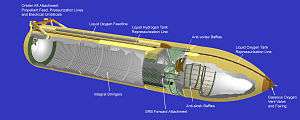Autogenous pressurization
Autogenous pressurization is the use of self-generated gaseous propellant to pressurize liquid propellant in rockets. Traditional liquid-propellant rockets have been most often pressurized with other gases, such as helium, which necessitates carrying the pressurant tanks along with the plumbing and control system to use it. Autogenous pressurization has been operationally used on the Titan 34D[1] and the Space Shuttle.[2] Autogenous pressurization is planned to be used on the SLS,[3] Starship,[4] and Terran 1.[5]

Background
In autogenous pressurization, a small amount of propellant is heated until it turns to gas. That gas is then fed back into the liquid propellant tank it was sourced from. This helps keep the liquid propellant at the required pressure necessary to feed a rocket's engines.[6] This is achieved through gas generators in a rocket's engine systems: tapped off from a gas generator; fed through a heat exchanger; or via electric heaters.[7] Autogenous pressurization was already in use in the Titan booster by 1968 and had been tested with the RL10 engine, demonstrating its suitability for upper stage engines.[8]
Traditionally, tank pressurization has been provided by a high pressure gas such as helium or nitrogen. This method of pressurization has been described as both less and more complex than using helium or nitrogen but it does provide significant advantages. The first is for long-term spaceflight and interplanetary missions such as going to and landing on Mars. Removing inert gases from usage allows engine firing in a non-pumping mode. The same vaporized gases can be used for mono or bi-propellant attitude control. The reuse of onboard oxidizer and fuel also reduces the contamination of combustibles by inert gases.[8]
Risk reduction benefits come from reducing the requirement of high pressure storage vessels and completely isolating fuel and oxidizer systems, removing a possible failure path via the pressurization subsystem. This system also increases payload capacity by reducing component and propellant weight and increased chamber pressure.[8]
The RS-25 engines used autogenous pressurization to maintain fuel pressure in the Space Shuttle external tank.[9]
References
- Inman, Arthur E; Muehlbauer, John G. (1980). "Shuttle Performance Augmentation with the Titan Liquid Boost Module". The Space Congress® Proceedings. 1980 (17th) A New Era In Technology: 66–76.
- "HSF – The Shuttle". spaceflight.nasa.gov. Retrieved April 19, 2020.
- Clark, Stephen. "SLS pathfinder stage arrives at Florida launch site – Spaceflight Now". Retrieved April 19, 2020.
- Ralph, Eric (May 9, 2019). "SpaceX's Starhopper gains thruster pods as hop test preparations ramp up". TESLARATI. Retrieved April 19, 2020.
- "Full Page Reload". IEEE Spectrum: Technology, Engineering, and Science News. Retrieved April 19, 2020.
- Ralph, Eric (April 2, 2020). "SpaceX Starship outfitted with Tesla battery packs and motors". TESLARATI. Retrieved April 19, 2020.
- Ralph, Eric (October 24, 2019). "SpaceX says Starship Mk1 will test 'skydiver' landing before the end of 2019". TESLARATI. Retrieved April 19, 2020.
- Christian, C.; Lehmann, E.; Ruby, L. (June 10, 1968), "Autogenous pressurization for space vehicle propulsion systems", 4th Propulsion Joint Specialist Conference, Joint Propulsion Conferences, American Institute of Aeronautics and Astronautics, doi:10.2514/6.1968-626
- "The External Tank". NASA. Retrieved April 15, 2019.